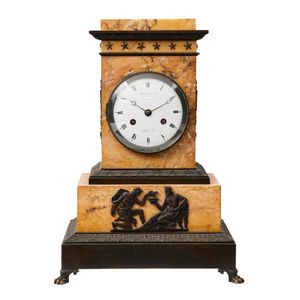French Empire Sienna Marble and Bronze Mantel Clock
A French Empire Sienna marble and bronze mantel clock, the enamelled dial signed Rabiat & Cie / Schuller, the silk suspension movement striking on a bell, the marble case in the form of an antique altar set with bronze acanthus mouldings, stars, lyres, and a bronze relief of Jupiter and Ganymede on bronze plinth standing on lion paw feet. Height 41 cm, width 30 cm, depth 19 cm. Provenance: The Estate of the Hon. Dr John Kennedy McLaughlin Am, Sydney
You must be a subscriber, and be logged in to view price and dealer details.
Subscribe Now to view actual auction price for this item
When you subscribe, you have the option of setting the currency in which to display prices to $Au, $US, $NZ or Stg.
This item has been sold, and the description, image and price are for reference purposes only.
- Acanthus - A stylized leaf motif, one of the primary decorative elements of classical Greek and Roman architecture, derived from the genus of flowering plants in the family Acanthaceae, native to tropical and subtropical regions of the Mediterranean area. It is a common element in classical Greek and Roman design, and is often seen in Corinthian and Composite order columns and used as a decorative element in English, European and Australian furniture, particularly on the curve of a leg, and as decoration for a corbel.
- Movement - The technical name for the workings of a clock or watch, and does not include the dial or case.
- Bronze - An alloy of copper and tin, traditionally in the proportions of about 9 parts of copper to 1 part of tin.
The discovery of bronze in Western Asia in the 4th century enabled people to create metal objects which were superior to those previoulsy possible because of its strength and hardness, and it has been used throughout the world for weapons, coins, tools, statuary and other decorative items.
It is very fluid in a molten state, and its hardness, strength when set, and non-corrosive properties makes it most suitable for casting sculpture.
This item has been included into following indexes:
